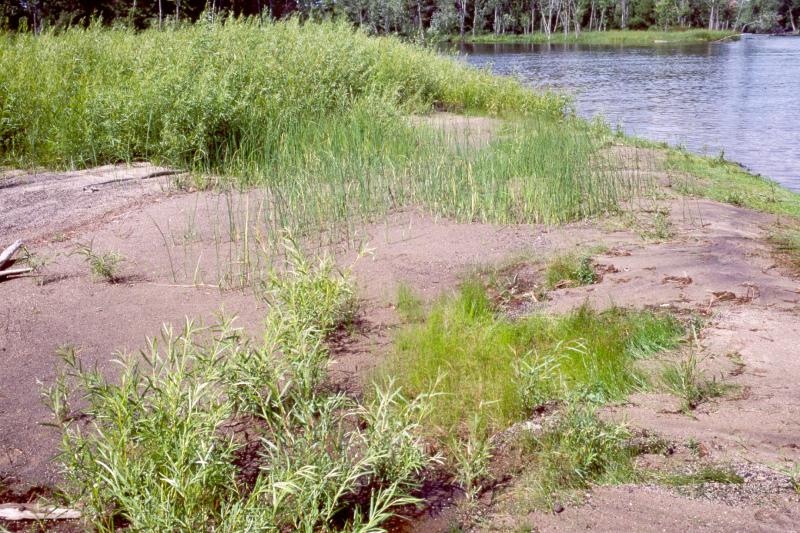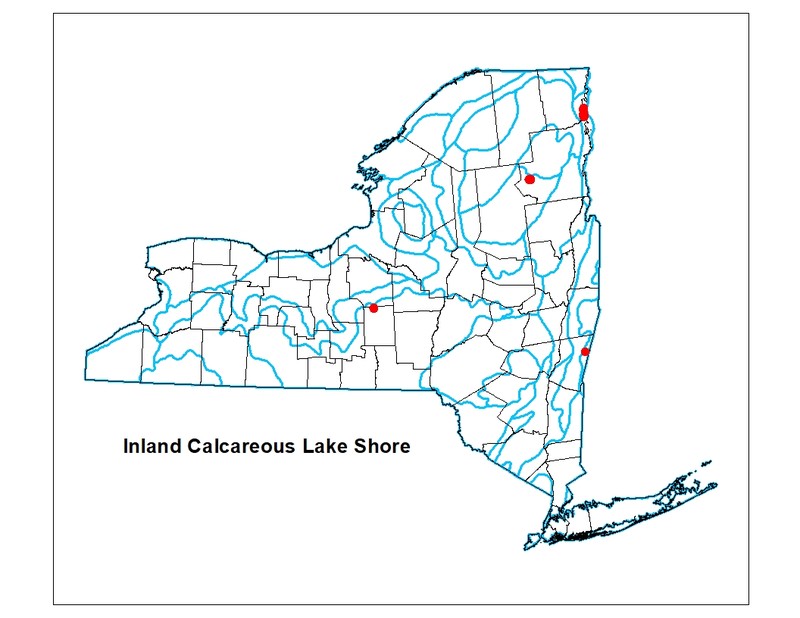Inland Calcareous Lake Shore
- System
- Palustrine
- Subsystem
- Open Mineral Soil Wetlands
- State Protection
- Not Listed
Not listed or protected by New York State.
- Federal Protection
- Not Listed
- State Conservation Status Rank
- S3
Vulnerable in New York - Vulnerable to disappearing from New York due to rarity or other factors (but not currently imperiled); typically 21 to 80 populations or locations in New York, few individuals, restricted range, few remaining acres (or miles of stream), and/or recent and widespread declines.
- Global Conservation Status Rank
- G4?
Apparently Secure globally (most likely) - Conservation status is uncertain, but most likely uncommon in the world but not rare; usually widespread, but may be rare in some parts of its range; possibly some cause for long-term concern due to declines or other factors. More information is needed to assign a firm conservation status.
Summary
Did you know?
Plants of inland lake shores must be adapted to fluctuating hydrologic conditions, ranging from complete inundation to complete exposure. One species found on inland lake shores, lake-cress (Neobeckia aquatica), is rare throughout much of its range. One mode of vegetative reproduction it employs, fragmentation, depends on fluctuating water levels. Flooding breaks pieces of foliage off the plant and transports it. When the water levels recede, the fragments settle on exposed saturated substrate, which supports their development into a separate plant.
State Ranking Justification
There are several hundred to one thousand occurrences statewide. A few documented occurrences have good viability and several are protected on public land or private conservation land. This community is limited to lake shores that remain wet in the state, and there are several high quality examples. The current trend of this community is probably stable for occurrences on public land, or declining slightly elsewhere due to moderate threats that include alteration to hydrology, shoreline development, and invasive species.
Short-term Trends
The number and acreage of inland calcareous lake shores in New York have probably declined slightly in recent decades as a result of shoreline development, hydrologic alteration, gravel mining, and invasive species.
Long-term Trends
The number and acreage of inland calcareous lake shores in New York have probably declined moderately from historical numbers likely correlated to the alteration of natural hydrology from impoundments, shoreline hardening, and gravel mining.
Conservation and Management
Threats
Inland calcareous lake shores are threatened by development (e.g., residential, agricultural, industrial) in the surrounding landscape. Structures built along the shoreline are a particular threat to this community (e.g., riprap, boat launches). Other threats include habitat alteration (e.g., instream gravel mining, road crossings, logging in adjacent floodplain), and relatively minor recreational overuse (e.g., boating, ATVs, trampling by visitors, fishing, trash dumping). Threats to adjacent lakes may apply to the inland calcareous lake shores (e.g., pollution, nutrient loading, sedimentation, impoundments and flooding, water release for rafting). Several inland calcareous lake shores are threatened by invasive species.
Conservation Strategies and Management Practices
Where practical, establish and maintain a natural wetland buffer to reduce storm-water, pollution, and nutrient run-off, while simultaneously capturing sediments before they reach the lake shore. Buffer width should take into account the erodibility of the surrounding soils, slope steepness, and current land use. Wetlands protected under Article 24 are known as New York State "regulated" wetlands. The regulated area includes the wetlands themselves, as well as a protective buffer or "adjacent area" extending 100 feet landward of the wetland boundary (NYS DEC 1995). If possible, minimize the number and size of impervious surfaces in the surrounding landscape. Avoid habitat alteration within the lake shore and surrounding landscape. For example, roads and trails should be routed around lake shores, and ideally not pass through the buffer area. If the lake shore must be crossed, then bridges and boardwalks are preferred over filling. Restore sites that have been unnaturally disturbed (e.g., remove obsolete impoundments and ditches in order to restore the natural hydrology). Prevent the spread of invasive exotic species into the lake shore through appropriate direct management, and by minimizing potential dispersal corridors, such as roads.
Development and Mitigation Considerations
Where practical, establish and maintain a natural lake shore buffer to filter storm-water, pollution, and nutrient run-off from surrounding uplands and to capture sediments before they reach the lake shore. Avoid habitat alteration along the shoreline and in surrounding landscape. Minimize potential dispersal corridors for exotic species, such as roads and bridges. Maintain or restore the natural flood and ice scour regime.
Inventory Needs
Survey for occurrences statewide to advance documentation and classification of inland calcareous lake shores. Continue searching for large sites in good condition (A- to AB-ranked).
Research Needs
Research composition of inland calcareous lake shores statewide in order to characterize variations. More data are needed to clearly separate this community from inland non-calcareous lake shore, cobble shore wet meadow, and marl pond shore.
Rare Species
- Carex atherodes (Wheat Sedge) (guide)
- Carex buxbaumii (Brown Bog Sedge) (guide)
- Carex capillaris (Hair-like Sedge) (guide)
- Carex lupuliformis (False Hop Sedge) (guide)
- Carex molesta (Troublesome Sedge) (guide)
- Carex schweinitzii (Schweinitz's Sedge) (guide)
- Carex sychnocephala (Many-headed Sedge) (guide)
- Eleocharis equisetoides (Horsetail Spike Rush) (guide)
- Graphephorum melicoides (Melic Oats) (guide)
- Isoetes riparia (Riverbank Quillwort) (guide)
- Pycnanthemum verticillatum var. verticillatum (Whorled Mountain Mint) (guide)
- Rorippa aquatica (Lake Water Cress) (guide)
Range
New York State Distribution
This community is widespread throughout upstate New York north of the North Atlantic Coast Ecoregion. It is probably represented by different ecoregional variants. Occurrences are known from the Allegheny Plateau, Adirondacks, Lake Ontario and Lake Champlain Lowlands. Other occurrences are reported from the Taconic Highlands. It is probably concentrated in the Great Lakes Ecoregion.
Global Distribution
This physically broadly-defined community may occur worldwide. Examples with the greatest biotic affinities to New York occurrences are suspected to span north to southern Canada, west to Minnesota, southwest to Indiana and Tennessee, southeast to North Carolina and northeast to Nova Scotia
Best Places to See
- Valcour Island Primitive Area, Adirondack Park
- Ausable Point Public Campground, Adirondack Park
- Adirondack Park
- Beebe Hill State Forest
Identification Comments
General Description
Inland calcareous shoreline communities occur on the perimeters of calcareous lakes, and have gravel, sand, or mud soils. The water levels fluctuate seasonally, with periods of flooding and periods of saturation and exposed substrate. The vegetation, which may be sparse, is composed primarily of herbaceous species that are adapted to calcium-rich environments. Characteristic species include spikerushes (Eleocharis acicularis, S. palustris), bulrushes (Schoenoplectus acutus, S. tabernaemontani), and water-crowfoot (Ranunculus flammula).
Characters Most Useful for Identification
A gravel, sand, or mud shoreline around an inland pond or lake with calcareous water and seasonally fluctuating water levels. The vegetation may be sparse and is typically dominated by herbaceous species.
Elevation Range
Known examples of this community have been found at elevations between 90 feet and 476 feet.
Best Time to See
During late summer, when water levels are at their lowest, the greatest diversity of herbaceous plants can be observed. The exposed substrate along the water's edge can feature a large variety of sedges, rushes, and forbs.
Inland Calcareous Lake Shore Images
Classification
International Vegetation Classification Associations
This New York natural community encompasses all or part of the concept of the following International Vegetation Classification (IVC) natural community associations. These are often described at finer resolution than New York's natural communities. The IVC is developed and maintained by NatureServe.
- Prairie Cordgrass North Atlantic Coast Marsh (CEGL006095)
NatureServe Ecological Systems
This New York natural community falls into the following ecological system(s). Ecological systems are often described at a coarser resolution than New York's natural communities and tend to represent clusters of associations found in similar environments. The ecological systems project is developed and maintained by NatureServe.
- Laurentian-Acadian Lakeshore Beach (CES201.586)
- Northern Atlantic Coastal Plain Pond (CES203.518)
Characteristic Species
-
Emergent aquatics
- Alisma subcordatum (southern water-plantain)
- Bidens spp.
- Eleocharis acicularis (needle spike-rush)
- Eleocharis palustris (common spike-rush)
- Heteranthera dubia (water star-grass)
- Juncus canadensis (Canada rush)
- Leersia oryzoides (rice cut grass)
- Neobeckia aquatica
- Pontederia cordata (pickerelweed)
- Ranunculus flammula var. reptans (narrow-leaved creeping spearwort)
- Ranunculus longirostris
- Ranunculus repens (creeping butter-cup, creeping crow-foot)
- Schoenoplectus acutus var. acutus (hard-stemmed bulrush)
- Schoenoplectus tabernaemontani (soft-stemmed bulrush)
- Spartina pectinata (prairie cord grass)
- Typha latifolia (wide-leaved cat-tail)
Similar Ecological Communities
- Coastal plain pond shore
(guide)
Coastal plain ponds have sandy, gravelly, or mucky soils, and have fluctuating water levels, but they are geographically restricted to the Coastal Lowlands and Long Island.
- Inland non-calcareous lake shore
Inland non-calcareous lake shores have gravel, sand, or mud substrate, and have fluctuating water levels, but the vegetation is composed of non-calciphilic herbaceous species, such as smartweed (Persicaria pensylvanica), marsh purslane (Ludwigia palustris), and water lobelia (Lobelia dortmanna).
- Marl pond shore
(guide)
These shore communities are similar in that they are both located at the upper fringe of waterbodies that usually draw down in most years. However, marl pond shores are associated with smaller marl ponds that have marl deposits on the substrate and vegetation, with a mat of stranded stoneworts (Chara sp.), and dominated by tufted hair grass (Deschampsia cespitosa). Whereas, inland calcareous lake shores are associated with larger lakes, lack marl and stoneworts, and dominated by freshwater cordrass (Spartina pectinata) and various bulrushes (Schoenoplectus spp.)
Vegetation
Percent cover
This figure helps visualize the structure and "look" or "feel" of a typical Inland Calcareous Lake Shore. Each bar represents the amount of "coverage" for all the species growing at that height. Because layers overlap (shrubs may grow under trees, for example), the shaded regions can add up to more than 100%.
Additional Resources
References
Cowardin, L.M., V. Carter, F.C. Golet, and E.T. La Roe. 1979. Classification of wetlands and deepwater habitats of the United States. U.S. Fish and Wildlife Service. Washington, D.C. 131 pp.
Edinger, G. J., D. J. Evans, S. Gebauer, T. G. Howard, D. M. Hunt, and A. M. Olivero (editors). 2014. Ecological Communities of New York State. Second Edition. A revised and expanded edition of Carol Reschke’s Ecological Communities of New York State. New York Natural Heritage Program, New York State Department of Environmental Conservation, Albany, NY. https://www.nynhp.org/ecological-communities/
Edinger, Gregory J., D.J. Evans, Shane Gebauer, Timothy G. Howard, David M. Hunt, and Adele M. Olivero (editors). 2002. Ecological Communities of New York State. Second Edition. A revised and expanded edition of Carol Reschke's Ecological Communities of New York State. (Draft for review). New York Natural Heritage Program, New York State Department of Environmental Conservation. Albany, NY. 136 pp.
New York Natural Heritage Program. 2024. New York Natural Heritage Program Databases. Albany, NY.
New York State Department of Environmental Conservation. 1995. Freshwater Wetlands: Delineation Manual. July 1995. New York State Department of Environmental Conservation. Division of Fish, Wildlife, and Marine Resources. Bureau of Habitat. Albany, NY.
Reschke, Carol. 1990. Ecological communities of New York State. New York Natural Heritage Program, New York State Department of Environmental Conservation. Latham, NY. 96 pp. plus xi.
Links
About This Guide
This guide was authored by: Gregory J. Edinger
Information for this guide was last updated on: February 6, 2024
Please cite this page as:
New York Natural Heritage Program. 2024.
Online Conservation Guide for
Inland calcareous lake shore.
Available from: https://guides.nynhp.org/inland-calcareous-lake-shore/.
Accessed July 27, 2024.

